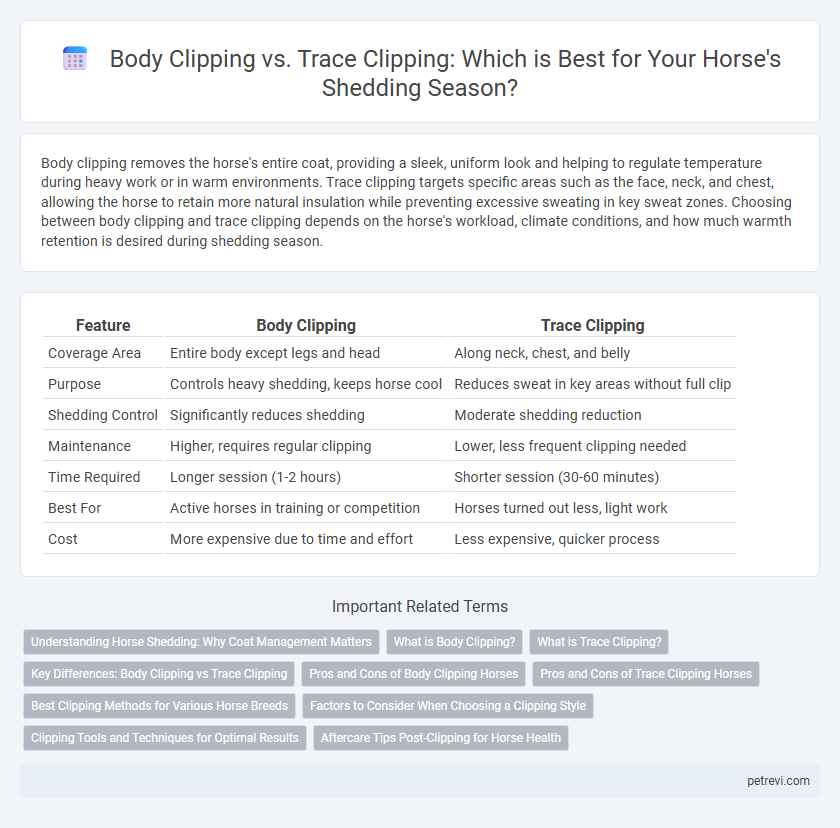Body clipping removes the horse's entire coat, providing a sleek, uniform look and helping to regulate temperature during heavy work or in warm environments. Trace clipping targets specific areas such as the face, neck, and chest, allowing the horse to retain more natural insulation while preventing excessive sweating in key sweat zones. Choosing between body clipping and trace clipping depends on the horse's workload, climate conditions, and how much warmth retention is desired during shedding season.
Table of Comparison
| Feature | Body Clipping | Trace Clipping |
|---|---|---|
| Coverage Area | Entire body except legs and head | Along neck, chest, and belly |
| Purpose | Controls heavy shedding, keeps horse cool | Reduces sweat in key areas without full clip |
| Shedding Control | Significantly reduces shedding | Moderate shedding reduction |
| Maintenance | Higher, requires regular clipping | Lower, less frequent clipping needed |
| Time Required | Longer session (1-2 hours) | Shorter session (30-60 minutes) |
| Best For | Active horses in training or competition | Horses turned out less, light work |
| Cost | More expensive due to time and effort | Less expensive, quicker process |
Understanding Horse Shedding: Why Coat Management Matters
Horse shedding is a natural process where the coat transitions between winter and summer layers, impacting thermoregulation and comfort. Body clipping removes the entire winter coat for faster drying and reduced sweat buildup during work, while trace clipping targets specific sweat-prone areas to balance warmth and airflow. Proper coat management through body or trace clipping minimizes skin irritation and maintains optimal performance and health during seasonal changes.
What is Body Clipping?
Body clipping is a thorough grooming technique that involves shaving the horse's entire body coat to control excessive sweating and enhance cooling after exercise. This method is often used for performance horses during winter months to prevent chill and reduce the need for frequent bathing. Body clipping helps maintain hygiene by minimizing sweat build-up and promoting faster drying.
What is Trace Clipping?
Trace clipping is a grooming technique used on horses to remove sweat-prone areas of the coat, primarily along the belly, chest, and flanks, without shaving the entire body. This method helps manage moisture and prevents discomfort during exercise in colder months, allowing the horse's natural coat to retain warmth in less sweaty areas. Trace clipping is particularly popular among sport horses that require moderate cooling without compromising insulation.
Key Differences: Body Clipping vs Trace Clipping
Body clipping removes the entire horse's coat, promoting faster drying and cleaner appearance, ideal for horses in heavy work or show conditions. Trace clipping targets sweat-prone areas like the neck, chest, and belly, balancing heat regulation while retaining a natural winter coat for warmth. Choosing between body clipping and trace clipping depends on the horse's workload, climate, and management needs to optimize comfort and performance.
Pros and Cons of Body Clipping Horses
Body clipping horses accelerates shedding by removing the entire winter coat, which helps regulate temperature during work and reduces sweat buildup. However, body clipping can leave horses vulnerable to cold weather without proper blankets and requires more frequent clipping sessions to maintain a smooth coat. This method demands significant time and effort but results in a cleaner, healthier coat compared to trace clipping, which only removes patches and is less effective for heavy shedders.
Pros and Cons of Trace Clipping Horses
Trace clipping horses involves shaving only the areas where the horse sweats the most, such as along the neck, chest, and belly, helping to regulate body temperature during exercise while maintaining some natural coat protection against cold. Pros of trace clipping include reduced grooming time and preventing excessive sweating without full body exposure, which is ideal for horses in moderate climates or light work. Cons include uneven coat protection, leaving some areas vulnerable to chills, and sometimes insufficient sweat management for intensely active horses or colder environments.
Best Clipping Methods for Various Horse Breeds
Body clipping offers thorough coat removal, ideal for heavy winter coats in breeds like Draft horses and Warmbloods that sweat heavily during work. Trace clipping, which targets specific sweat zones such as the chest and girth, suits lighter breeds such as Arabians and Thoroughbreds, preserving natural insulation while managing sweat efficiently. Selecting the best clipping method depends on breed coat thickness, workload intensity, and climate conditions to ensure optimal shedding and comfort.
Factors to Consider When Choosing a Clipping Style
When choosing between body clipping and trace clipping for horse shedding, factors such as climate, workload, and the horse's natural coat thickness play crucial roles in deciding the appropriate method. Body clipping removes most of the winter coat, ideal for horses with heavy work schedules in warm stables, while trace clipping targets areas prone to sweating, preserving more coat for insulation. Owners must assess the horse's environment, exercise intensity, and grooming time to optimize comfort and health during the shedding process.
Clipping Tools and Techniques for Optimal Results
Body clipping uses full coat removal tools like large electric clippers with wide blades to achieve a smooth, even finish while maintaining horse comfort during shedding seasons. Trace clipping targets specific areas such as the neck, chest, and flanks, employing smaller, precision clippers or detachable blades to reduce sweat accumulation and enhance breathability without removing the entire coat. Optimal results depend on selecting high-quality clippers with adjustable speeds, sharp blades, and applying consistent, gentle strokes to prevent skin irritation and ensure efficient hair removal.
Aftercare Tips Post-Clipping for Horse Health
After body clipping or trace clipping a horse, prioritize thorough cleaning of the clipped areas to prevent irritation and infection. Apply a soothing balm or moisturizing spray to maintain skin hydration and support healing, especially in sensitive regions exposed during clipping. Monitor the horse for signs of sunburn or chills, providing appropriate blankets or shade to protect the skin and ensure comfort during shedding transitions.
Body Clipping vs Trace Clipping for Horse Shedding Infographic

 petrevi.com
petrevi.com